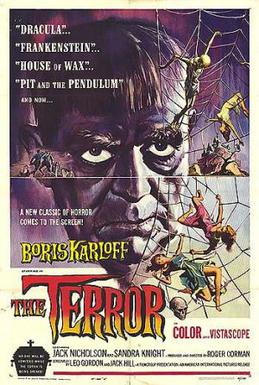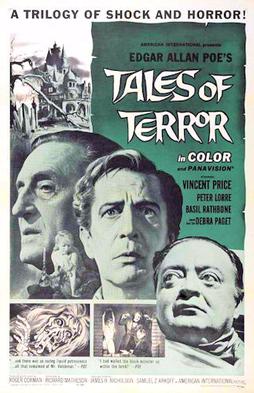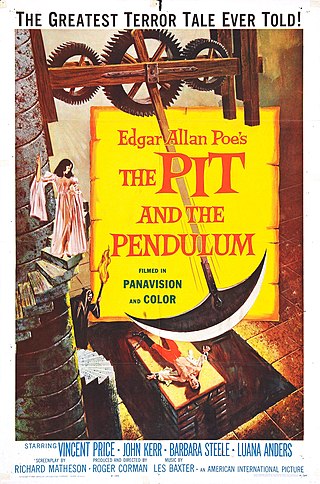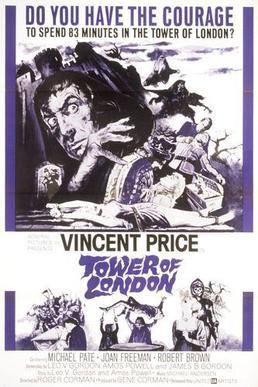
Richard Burton Matheson was an American author and screenwriter, primarily in the fantasy, horror, and science fiction genres.

Peter Lorre was a Hungarian and American actor, active first in Europe and later in the United States. He began his stage career in Vienna, in the Austro-Hungarian Empire, before moving to Germany where he worked first on the stage, then in film in Berlin in the late 1920s and early 1930s. Lorre caused an international sensation in the Weimar Republic–era film M (1931), directed by Fritz Lang, in which he portrayed a serial killer who preys on little girls. Known for his timidly devious characters, his appearance, and his accented voice, Lorre was frequently caricaturized during and after his lifetime and the cultural legacy of his persona remains in media today.

Roger William Corman was an American film director, producer, and actor. Known under various monikers such as "The Pope of Pop Cinema", "The Spiritual Godfather of the New Hollywood", and "The King of Cult", he was known as a trailblazer in the world of independent film.
American International Pictures LLC is an American film production company owned by Amazon MGM Studios. In its original operating period, AIP was an independent film production and distribution company known for producing and releasing films from 1955 until 1980, a year after its acquisition by Filmways in 1979.

The Tomb of Ligeia is a 1964 British horror film directed by Roger Corman. Starring Vincent Price and Elizabeth Shepherd, it tells of a man haunted by the spirit of his dead wife and her effect on his second marriage. The screenplay by Robert Towne was based upon the short story "Ligeia" by American author Edgar Allan Poe and was the last in his series of films loosely based on the works of Poe. Tomb of Ligeia was filmed at Castle Acre Priory and other locations with a mostly British cast.

Hazel Court was an English actress. She is known for her roles in British and American horror films during the 1950s and early 1960s, including Terence Fisher's The Curse of Frankenstein (1957) and The Man Who Could Cheat Death (1959) for Hammer Film Productions, and three of Roger Corman's adaptations of Edgar Allan Poe stories for American International Pictures: The Premature Burial (1962), The Raven (1963) and The Masque of the Red Death (1964).

The Terror is a 1963 American independent horror film produced and directed by Roger Corman. The film stars Boris Karloff and Jack Nicholson, the latter of whom portrays a French officer who is seduced by a woman who is also a shapeshifting devil.

Tales of Terror is a 1962 American International Pictures comedy horror film in colour and Panavision, produced by Samuel Z. Arkoff, James H. Nicholson, and Roger Corman, who also directed. The screenplay was written by Richard Matheson, and the film stars Vincent Price, Peter Lorre, and Basil Rathbone. It is the fourth in the so-called Corman-Poe cycle of eight films, largely featuring adaptations of Edgar Allan Poe stories and directed by Corman for AIP. The film was released in 1962 as a double feature with Panic in Year Zero!.

The Raven is a 1935 American horror film directed by Louis Friedlander and starring Boris Karloff and Béla Lugosi. Billed as having been "suggested by" Edgar Allan Poe's 1845 poem of the same title, excerpts of which are quoted at a few points in the film, it was adapted from an original screenplay by David Boehm. Lugosi stars as a neurosurgeon obsessed with Poe who has a torture chamber in his basement, and Karloff plays an escaped murderer on the run from the police who Lugosi manipulates into doing his dirty work.

Edgar Allan Poe's poem "The Raven" has been frequently referenced and parodied in contemporary culture. Immediately popular after the poem's publication in 1845, it quickly became a cultural phenomenon. Some consider it the best poem ever written. As such, modern references to the poem continue to appear in popular culture.

The Masque of the Red Death is a 1964 horror film directed by Roger Corman and starring Vincent Price. The story follows a prince who terrorizes a plague-ridden peasantry while merrymaking in a lonely castle with his jaded courtiers. The screenplay, written by Charles Beaumont and R. Wright Campbell, was based upon the 1842 short story of the same name by American author Edgar Allan Poe, and incorporates a subplot based on another Poe tale, "Hop-Frog". Another subplot is drawn from Torture by Hope by Auguste Villiers de l'Isle-Adam.

House of Usher is a 1960 American gothic horror film directed by Roger Corman and written by Richard Matheson from the 1839 short story "The Fall of the House of Usher" by Edgar Allan Poe. The film was the first of eight Corman/Poe feature films and stars Vincent Price, Myrna Fahey, Mark Damon and Harry Ellerbe.

The Pit and the Pendulum is a 1961 horror film directed by Roger Corman, starring Vincent Price, Barbara Steele, John Kerr, and Luana Anders. The screenplay by Richard Matheson was loosely inspired by Edgar Allan Poe's 1842 short story of the same name. Set in sixteenth-century Spain, the story is about a young Englishman who visits a forbidding castle to investigate his sister's mysterious death. After a series of horrific revelations, apparently ghostly appearances and violent deaths, the young man becomes strapped to the titular torture device by his lunatic brother-in-law during the film's climactic sequence.

The Comedy of Terrors is a 1963 American International Pictures horror comedy film directed by Jacques Tourneur and starring Vincent Price, Peter Lorre, Basil Rathbone, Boris Karloff and Joe E. Brown in his final film appearance. It is a blend of comedy and horror that features several cast members from Tales of Terror, a 1962 film also released by AIP.

The Haunted Palace is a 1963 horror film released by American International Pictures, starring Vincent Price, Lon Chaney Jr. and Debra Paget, in a story about a village held in the grip of a dead necromancer. The film was directed by Roger Corman and is one of his series of eight films largely based on the works of American author Edgar Allan Poe.
"The Raven" is a narrative poem by Edgar Allan Poe.

American poet and short story writer Edgar Allan Poe has had significant influence in television and film. Many are adaptations of Poe's work, others merely reference it.

Tower of London is a 1962 historical drama and gothic horror film directed by Roger Corman and starring Vincent Price and Michael Pate. The film was produced by Edward Small Productions.
The Horror Hall of Fame was an annual Oscars-style award show hosted by Robert Englund which honored the best horror films, television series, actors, producers and special-effects designers. It ran for three years during October from 1990 to 1992 and was shown in syndication. At the end of Horror Hall of Fame III, the host promised a Horror Hall of Fame IV, but it never happened. All 3 shows was held at Universal Studios Hollywood.
Olive Sturgess is a Canadian former actress who worked in films, television shows, and theatre in the 1950s and 1960s. Her parents were Mr. and Mrs. Leonard Sturgess. Leonard hosted his own radio show. She came to Hollywood in 1954.















